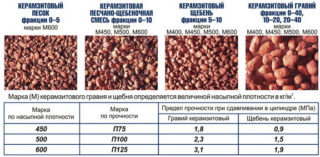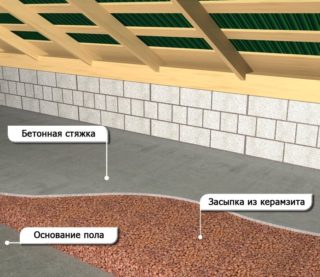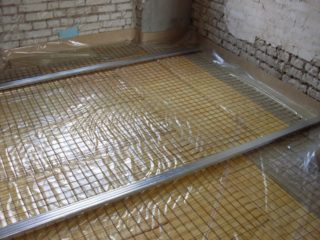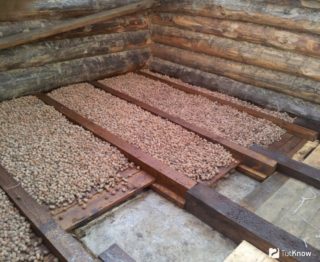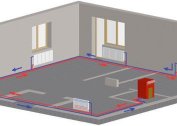Bridges of cold can pass through the surface of the floor in the house in the same way as through walls or the roof. Therefore, in order to save heating, it must be insulated. There are a lot of technologies from simple to complex in execution, from budget to expensive. Due to environmental degradation, people tend to use safer materials in their home improvement. Expanded clay as a heater fully meets these needs. There are several ways to organize from it a heat-insulating barrier to the floor surface.
Properties and advantages of expanded clay
Lightweight expanded clay material is a rounded granule obtained by firing clay of low-melting varieties. They make it in special rotary kiln drums. The main properties include:
- Good thermal insulation ability - it directly depends on the size of the fraction. In numerical value, the average thermal conductivity is 0.18-0.1 W / (m * K).
- High strength indicator - from 600 to 250 kilograms per cubic meter.
- Soundproof qualities.
- Resistance to chemically active liquids.
- The ability to withstand negative and high temperatures, as well as direct exposure to fire.
All this makes the material universal and suitable for use in various fields of construction.
Characteristics of the material depending on the size of the fraction
Expanded clay for insulation is produced in granules of three main categories according to grain size:
- The sand fraction is characterized by an average element size in the structure of 10-5 millimeters.
- The gravel fraction has an indicator of the size of the granules in the range of 20-10 millimeters in the total mass.
- The crushed stone fraction is the largest and contains grains with a diameter of 40 to 20 millimeters.
If you take the mass of a cube of bulk material, the heaviest is fine sand, which weighs 450 kg. Further 50 kg is easier to gravel and another 50 gravel. Operational characteristics are almost the same for all categories of this building material.
Expanded clay floor insulation
Regardless of the method of organizing the heat-insulating barrier based on sintered clay, there are certain similar technological points:
- The waterproofing device is the very first layer of the cake necessary to prevent moisture from entering the bulk of the dump. Water-impregnated granules become more thermally conductive.
- Filling pillows made of expanded clay as a floor insulation. It is carried out using beacons set to the required height.
- Fixing the insulation layer with screed or other pre-flooring.
All these stages have certain subtleties, depending on the particular chosen method of floor insulation with expanded clay in a wooden house or other housing.
Dry styling
The method is quick and easy to implement. The device is based on a thermal cushion by a simple embankment and leveling of sintered clay along the plane of the floor base. Leveling is carried out by orientation on previously exposed beacons. After filling, the floor is equipped. It can be chipboard or OSB boards, as well as special polystyrene foam. The layer thickness during dry installation should not be less than 0.1 meters.
So that over time the floor does not push the pillow, you should give preference to the smallest fraction of the insulation.
Wet styling technology
A more complicated and expensive method than dry laying. Assumes the use of sintered clay as a filler for concrete. The liquid mixture is poured like an ordinary screed, relying on level guides installed on a level. The method is used mainly on floors where there is a sharp difference in height and significant irregularities.
The disadvantage of such insulation can be considered the fact that the rounded pebble, saturated with moisture, loses much of its heat-insulating properties, and the cement mortar perfectly conducts cold.
Combined Warming Method
This method combines the elements of dry and wet styling. From the first technology, the stages of the waterproofing layer and the filling of the insulated pillow from sintered clay of the required thickness are taken. Next, prepare a liquid cement mortar, which simply shed the leveled surface, in order to form a strong surface crust. After complete hardening of the latter, a concrete screed is arranged above it.
A positive aspect of the method can be considered the preservation by granules of their properties of poor thermal conductivity. Another convenience of the technology is that clay pebbles do not float to the surface of concrete, which is observed in the wet method.
Warm screed on expanded clay
Warming the base of the floor in this way consists of adding clay granules as a filler in concrete instead of ordinary stone gravel. The proportion of sand to cement in such a mixture is 2: 1, and the amount of insulation is determined by the load to which the floor will be exposed during operation and is 5-3 parts.
Standard screed organization technology:
- Waterproofing is laid on the floor.
- Expose the reinforcing grill on the stands.
- Along the entire plane with lines, guide beacons are fixed.
- The prepared solution fills the space between the beacons, without adding 3-2 centimeters.
- After the concrete has set, the surface is topped up to zero with ordinary cement mortar.
You can use the surface in a month.
Expanded clay insulation between lags
The basis of the method in this case is the installation of the frame of the bars on the ground, concrete. Wood should be insulated from moisture by a film and treated with high-quality antiseptics. The lag is fastened rigidly with the help of angles and screws parallel to each other in a horizontal position in level. The height of the space from the ground to the upper plane should not be less than 0.1 meters.
Between the bars, a heater is poured, then everything is covered with a vapor barrier membrane and wood panels are mounted. The convenience of such an organization of the insulating layer is that there is no need to level the bulk material, concrete is not used, the overall complexity of the work is reduced.
Recommendations for floor insulation
If improperly performed with expanded clay insulation, the floor may remain cold, so you need to know some subtleties.
- The thickness of the pillow made of granules of 10 cm corresponds to the thickness of the wood of 30-25 cm, depending on the moisture content of the latter. It has been experimentally proved that it makes no sense to make a layer of less than 0.1 meters.
- The best heat insulator is air, all other materials in one way or another conduct cold. Therefore, clay pebbles with an average fraction size, where there will be many air cells in the thickness, should be preferred. A very large fraction is not suitable, as drafts can walk under the floor, cooling the insulator.
- In the thickness of the screed, in no case can you leave metal guides or pins driven into the ground, since they are cold bridges.
Carrying out concrete work on the insulation device requires the mandatory use of a damping tape around the perimeter of the base of the room.

